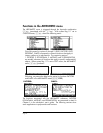
Page 5-11
FCOEF([2,1,0,3,–5,2,1,–2,–3,–5])=‘(X--5)^2*X^3*(X-2)/(X-+3)^5*(X-1)^2’
If you press µ„î` (or, simply µ, in RPN mode) you will get:
‘(X^6+8*X^5+5*X^4-50*X^3)/(X^7+13*X^6+61*X^5+105*X^4-
45*X^3-297*X62-81*X+243)’
The FROOTS function
The function FROOTS, in the ARITHMETIC/POLYNOMIAL menu, obtains
the roots and poles of a fraction. As an example, applying function
FROOTS to the result produced above, will result in: [1 –2. –3 –5. 0 3. 2
1. –5 2.]. The result shows poles followed by their multiplicity as a
negative number, and roots followed by their multiplicity as a positive
number. In this case, the poles are (1, -3) with multiplicities (2,5)
respectively, and the roots are (0, 2, -5) with multiplicities (3, 1, 2),
respectively.
Another example is: FROOTS(‘(X^2-5*X+6)/(X^5-X^2)’) = [0 –2. 1 –1. 3
1. 2 1.], i.e., poles = 0 (2), 1(1), and roots = 3(1), 2(1). If you have had
Complex mode selected, then the results would be:
[0 –2. 1 –1. – ((1+i*√3)/2) –1. – ((1–i*√3)/2) –1. 3 1. 2 1.].
Step-by-step operations with polynomials and
fractions
By setting the CAS modes to Step/step the calculator will show
simplifications of fractions or operations with polynomials in a step-by-step
fashion. This is very useful to see the steps of a synthetic division. The
example of dividing
is shown in detail in Appendix C of the calculator’s user’s guide. The
following example shows a lengthier synthetic division (DIV2 is available in
the ARITH/POLYNOMIAL menu):
2
235
23
−
−+−
X
XXX
1
1
2
9
−
−
X
X
SG49A.book Page 11 Friday, September 16, 2005 1:31 PM


















